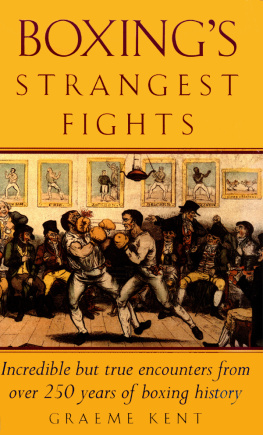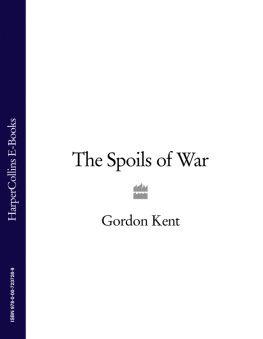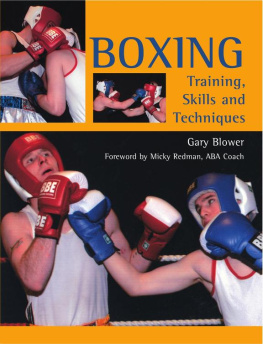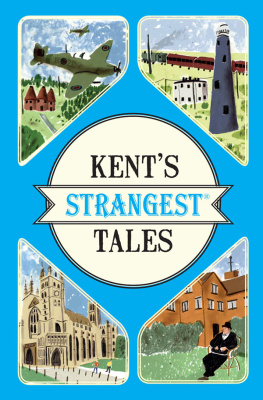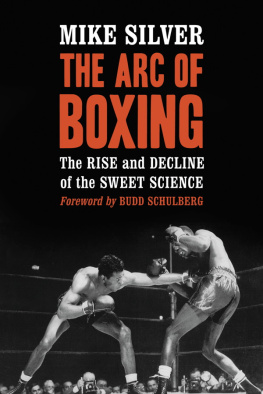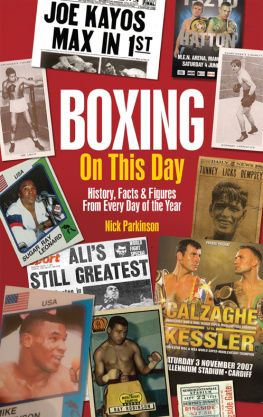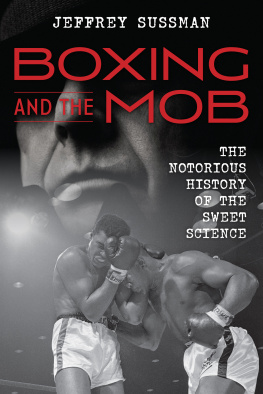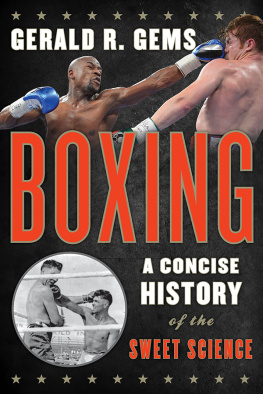BOXINGS
STRANGEST
FIGHTS
Other titles in this series
Footballs Strangest Matches Andrew Ward
Crickets Strangest Matches Andrew Ward
Horse Racings Strangest Races Andrew Ward
Golfs Strangest Rounds Andrew Ward
BOXINGS
STRANGEST
FIGHTS
GRAEME KENT

Contents
Introduction
Boxing attracts eccentrics. Perhaps you have to be a little crazy to have anything to do with the ring. There is great richness in its history and folklore, and I hope that I have done some justice to it in these pages.
I have been drawn to boxing and its legends ever since my sporting grandmother told me that she once felt the biceps of Freddy Welsh, later to be the world lightweight champion, when he was just starting out in the game in Pontypridd in 1905.
Several years earlier that same grandmother had served a whisky and water to Buffalo Bill Cody when he had ridden over from his touring Wild West Show to Tintern, where she was working as a barmaid. I never felt quite the same awe for the Buffalo Bill connection as I did about the one with Freddy Welsh.
In compiling the stories for this collection I have drawn upon many printed sources, but I have also gone to as many primary sources as possible. The task took me so long that many of the fighters and followers of the game who were so generous with their time and friendship are no longer with us.
I would like to thank T B Shepherd, compiler of the best of all boxing anthologies, The Noble Art. Shep spent many years as a schoolmaster in the tough Kings Cross area of London and taught a number of schoolboys who later became professional champions Danny and Dickie OSullivan, Terry Allen, and many others. Through him I met such ring luminaries as Danny OSullivan, the former bantamweight champion of Great Britain and a considerable raconteur in his own right.
From an older generation I am indebted to the memories of Johnny Cuthbert, featherweight and lightweight champion of Great Britain in the 1920s, who provided a fund of stories about boxing in this country between the wars.
Vic Hardwicke, the boxing statistician, came to my aid with details of the Monocled Boxer, Desmond Jeans, and is just one of the followers of the sport to whom I owe a debt.
Above all I am grateful to all those former boxers, champions and non-champions, who have spent so much time talking to me about the sport they practised with such courage and distinction. If the total time I have spent listening to their anecdotes about the ring were added up it would amount to quite a slice of my life. The rest I have probably wasted.
The Gentle Sex
London, June 1722
Organized boxing is generally considered to have got under way in Great Britain in 1719, when James Figg, the first heavyweight champion, opened his boxing academy, known as Figgs Amphitheatre.
Within three years women were also trying to get in on the act. It started with an advertisement in a London newspaper.
Challenge
I, Elizabeth Wilkinson, of Clerkenwell, having had some words with Hannah Hyfield, and requiring satisfaction, do invite her to meet me upon the stage, and box me for three guineas; each woman holding half-a-crown in her hand, and the first woman that drops the money to lose the battle.
Hannah Hyfield was just as spirited, because within a few days her reply appeared in the same journal.
Answer
I, Hannah Hyfield, of Newgate Market, hearing of the resoluteness of Elizabeth Wilkinson, will not fail, God willing, to give her more blows than words desiring home blows, and from her, no favour: she may expect a good thumping!
The projected match attracted a great deal of attention, but it never came off. The authorities clamped down upon the proposed meeting with great firmness. Both would-be contestants were informed that such an encounter would violate both public decency and ethics. If Elizabeth and Hannah attempted to go ahead with their bout they would both be thrown into prison.
The contest was cancelled, but other fighting ladies were to prove less easily intimidated. In June 1795, Mary Ann Fielding of Whitechapel fought an unnamed opponent. A contemporary account declared, Everything having been properly arranged, the combatants set-to, and for some time each displayed great intrepidity and astonishingly well-conducted manoeuvres in the art of boxing. The contest lasted over an hour before Fielding was declared the winner.
In December 1811, The Sporting Life described a pitched battle for a pint of gin and a new shawl. The bout took place between Molly Flower and Nanny Gent on Wormwood Scrubbs. The newspaper account went on: The set-to was contested for twenty minutes with some skill and determined courage. Both were good hitters, and they were worst hit about the head than is witnessed amongst many second-rate pugilists. Nanny jibbed a bit in the twelfth round and gave in from a dextrous hit down in the following round.
The diminutive Welshman Jimmy Wilde went on to become a wealthy flyweight champion of the world, but in his early days he was so impoverished that he could not afford a sparring partner. Instead his wife Lizbeth donned a special protector made from an old corset, and put on the gloves with her husband in his training sessions. Carrying her four-month old son David in her arms, Lizbeth would trudge many miles across the Welsh mountains to see her husband fight.
The Boys from Bristol
Hailsham, Sussex, October 1805
A number of well-known boxers have ended their careers in prison. John Gully was the first champion to begin his fighting life there.
He was the son of a Bristol butcher. In 1805, Gully found himself a prisoner in the Kings Bench prison for debt. While he was there he achieved something of a reputation as a fighter when he thrashed the prison bully.
News of the fighting debtor reached the ears of another Bristolian, Hen Pearce, better known as the Game Chicken, the bare-knuckle champion of England. Pearce visited Gully in the Kings Bench and suggested that they have a friendly set-to with the mufflers.
Gully acquitted himself so well in the sparring session that Pearce recommended him to a well-known patron of the prize-ring, Fletcher Read.
Read paid off Gullys debts on the understanding that the young West Country man embark upon a career as a prize-fighter. Gully was not reluctant, but after an initial training period he was aghast when told that in his first professional contest he had been matched against his benefactor, Hen Pearce, the champion of England.
The two men met shortly before the battle of Trafalgar was fought, at Hailsham, before a huge crowd. The Duke of Clarence, later William IV, watched the bout from horseback at the rear of the crowd.
The contest lasted sixty-four rounds, a total period of one hour and seventeen minutes. Gully put up a tremendous fight, but the experience of the champion was too much for him and he was forced to retire. After he had thrown in the sponge, Pearce came over and shook his hand.
Youre a damned good fellow, said the Game Chicken. Im hard put to it to stand. Youre the only man that ever stood up to me.
Pearce retired from the ring and John Gully was generally accepted as the new champion. He fought only twice more, each time against the Lancashire giant, John Gregson. In their first encounter, near Newmarket, Gully knocked his opponent out in thirty-six rounds.
Next page
